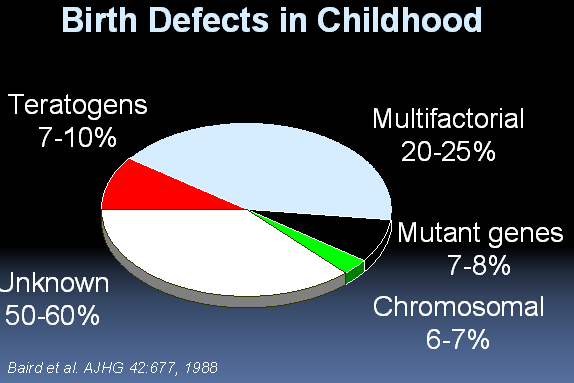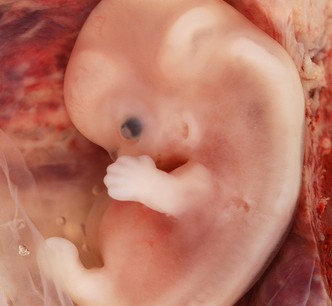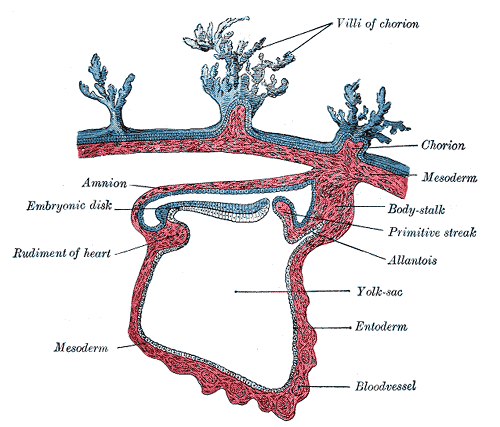Any structural, behavioral or metabolic disorders present at birth are known as birth defects.
Other related terms include:
a. Teratology/Dysmorphology
Branch of science which studies causes, mechanisms & patterns of abnormal development
b. Teratogen
A teratogen is an agent that can produce a permanent alteration of structure or function in an organism exposed during embryonic or fetal life. Or a factor that causes birth defects.
Until 1940, it was assumed that congenital defects were caused primarily by hereditary factors. In 1941, the first well-documented cases were reported that an environmental agent (rubella virus) could produce severe anatomic anomalies. In 1961 Lenz linked limb defects with thalidomide and proposed that drugs can cross placenta & produce birth defects.
Statistics:
1. Birth defects are the leading cause of infant mortality – 21% of infant deaths
2. Major structural anomalies (4-6%), which include 2% – 3% of live born infants & additional 2% – 3% recognized in children by age 5 years
3. Minor anomalies —- (15%)

There exists a certain correlation between minor and major anomalies. Minor anomalies such as microtia, pigmented spots and short palpebral fissures alone are not detrimental to health. It has been found that:
1. With one minor anomaly there is 3% chance of major anomaly.
2. With 2 minor anomalies there is 10% chance.
3. With 3 or more minor anomalies there is 20% chance.

Principles of Teratology:
Susceptibility to teratogenesis depends upon:
a. Genotype of the conceptus.
b. Time of exposure
c. Dose & duration of exposure to a teratogen.
d. Specific ways (mechanism) in which teratogen acts on developing cells.
e. Manifestations of abnormal development are death, malformation, growth retardation & functional disorders.
Types Of Abnormalities:
1. Malformations
Malformations occur during the formation of structures i.e. during organogenesis. Malformations result in complete or partial absence of a structure or in alterations of its normal configuration.
2. Disruptions
Disruptions result in morphological alterations of already formed structures. They are due to destructive processes. Some of the main examples include:
a. Vascular accidents leading to bowel atresias
b. Defects produced by amniotic bands
3. Deformations
Deformations are due to mechanical forces that mold a part of the fetus over a prolonged period and often involve musculoskeletal system. They may be reversible postnatally. Example includes
Club feet which is due to compression in the
amniotic cavity.
4. Syndrome:
Syndrome is a group of anomalies occurring together that have a specific common cause. In syndrome, the cause is known and the risk of recurrence is known.
Examples include:
a. Down’s syndrome
b. Fetal alcoholic syndrome
5. Association
Association is the non random appearance of two or more anomalies that occur together more frequently than by chance alone, but their cause is not known. Example includes: VACTERL
Recognition of one component promotes search for others in the group.
Teratogenic Agents
Teratogenic agents include:
1.Infectious agents
2.Physical agents
3.Drugs and chemical agents
4.Hormones
5.Maternal metabolic imbalances
b. Alcoholism
c. Phenylketonuria
1. Infectious agents:
a. Rubella Virus (German measles)
Rubella virus is an infective teratogen and causes approximately 20% risk. Vaccine is available against it. Congenital rubella syndrome (CRS) is associated with rubella virus. It is also known to cause:
- Cataracts
- Cardiac defects
- Deafness
b. Cytomegalovirus (CMV):
c. Herpes Simplex Virus (HSV)
Herpes Simplex Virus increases rate of abortion by 3 fold. It also causes higher rate of prematurity as well as:
- Microcephaly
- Microphthalmia
- Mental retardation
- Retinal dysplasia.
d. Varicella virus (Chickenpox)
The Varicella virus causes muscle atrophy, hypoplasia of the limbs and mental retardation.
e. HIV
HIV is known to cause growth failure and microcephaly.
f. Toxoplasma gondii (parasitic disease)
Toxoplasmosis causes:
- Hydrocephalus
- Cerebral calcifications
- Microphthalmia
- Chorioretinitis
g. Congenital Syphilis
Early fetal manifestations of congenital syphilis include:
- deafness
- mental retardation
Late fetal manifestations of untreated congenital syphilis are:
- Destructive lesions of the palate and nasal septum,
- Hutchinson teeth – (incisors centrally notched, widely spaced
- Abnormal facies (frontal bossing, saddlenose, poorly developed maxilla).
2. Physical agents
a. Radiation (X rays/ ionizing radiations) kills rapidly proliferating cells, and is thus a mutagenic agent. It also causes microcephaly, spina bifida, cleft palate and limb defects.
b. Hyperthermia causes anencephaly, spina bifida, mental retardation, cleft palate, cleft lip and limb defects.
3. Chemical agents / drugs
Known teratogenic drugs
Known teratogenic drugs include:
- Androgens
- ACE inhibitors
- Antineoplastic agents)
- Anti-epileptic drugs: Carbamazepine, Phenytoin, Valproic acid
- Cocaine
- Coumarins (warfarin)
- Diethylstilboestrol
- Fluconazole (high-dose)
- Ethanol
- Lithium
- Methimazole
- Penicillamine
- Retinoids; isotretinoin, n
- Thalidomide
- Tetracyclines
Possible teratogens
Possible teratogens include:
- Cigarette smoking
- Colchicine
- Disulfiram
- Ergotamine
- Ethanol
- Glucocorticoids
- Primidone
- Pseudoephedrine
- Streptomycin
- Trimethoprim
- Vitamin A (> 25,000 U/day)
- Zidovudine
Thalidomide (1957-1961)
Thalidomide is a sedative and anti nauseant drug. Critical periods while using this drug include:
21-22 days: resulting in absent external ears and cranial nerve disorders
24-27 days: resulting in phocomelia (especially arms)
27-28 days: resulting in phocomelia (especially lower limbs)
34-36 days: resulting in hypoplastic thumbs and anorectal stenosis
The drug was withdrawn in 1961; no new cases of these defects have been reported.
Antiepileptics
Antiepileptics include dilantin,valproic acid and trimethadione. They are associated with characteristic dysmorphogenesis. Facial clefts are common. Other defects include m icrocephaly, nail dysplasia and developmental delay. Valproic acid is also associated with neural tube defects.
Anticoagulants
All anticoagulants except heparin have some correlation with birth defects. Warfarin is definitely a teratogen. Anticoagulants are associated with hypoplasia of nasal cartilage, stippled epiphyses and various CNS defects.
Tetracyclines
Tetracyclines are associated with acute fatty liver, hepatotoxicity, stained decidual teeth, under developed enamel, heart defects and club foot.
Angiotensin-converting enzyme ( ACE )inhibitors
Angiotensin-converting enzyme inhibitors have been known to cause oligohydramnios, hypoplasia of the skull bones, intrauterine growth restriction (IUGR),
renal dysfunction and fetal death.
Insulin and Hypoglycemic Drugs
Insulin is not teratogenic in human embryos. Hypoglycemic drugs (e.g., tolbutamide) have been implicated, but evidence of their teratogenicity is weak. The incidence of congenital anomalies (e.g., sacral agenesis) is increased two to three times in the offspring of diabetic mothers.
Retinoic Acid(Vitamin A) Embryopathy
Isotretinoin (13-cis-retinoic acid), used for treating severe cystic acne, is a known human teratogen. The critical period is 5 – 7 weeks after the LMP. It is associated with spontaneous abortion and birth defects. Microtia, micrognathia, cleft palate and/or thymic aplasia, CVS anomalies, and neural tube defects have also been found.
Fetal Alcohol Syndrome (FAS)
Severe form of fetal alcohol syndrome is associated with:
a. Microcephaly
b. Mental retardation (leading cause)
c. Cardiac and renal abnormalities
d. Maxillary hypoplasia
Mild form of fetal alcohol syndrome is associated with:
a. Growth retardation
b. Attention deficits with normal intelligence
Increased prenatal alcohol exposure also causes a smooth philtrum i.e. the groove between the nose and upper lip flattens, thin vermilion (upper lip thins) and small palpebral fissures (eye width decreases).
4. Social Drugs
Cocaine
Cocaine causes spontaneous abortion, prematurity, intrauterine growth restriction (IUGR), microcephaly, cerebral infarction, urogenital anomalies, neurobehavioral disturbances and neurologic abnormalities.
Caffeine
Caffeine is not a teratogen
Nicotine
Nicotine is associated with IUGR; it is not a teratogen.
5. Hormones
Androgenic agents:
Synthetic progestins (ethisterone, norethisterone) to prevent abortion, have androgenic action. They result in masculinization of female genitalia.
Diethylstilbestrol (DES)
Diethylstilbestrol is a synthetic estrogen to prevent abortion. It might cause carcinomas of cervix and vagina in women exposed to it in utero.
Oral contraceptive pills
Oral contraceptive pills (containing estrogen and progestogen) have low teratogenic potential.
Cortisone
Cortisone causes cleft palate and cardiac defects in susceptible strains of mice and rabbits. Low doses of corticosteroids do not induce cleft palate or any other congenital anomaly in human embryos.
6. Maternal disease
Disturbances in carbohydrate metabolism in diabetic mothers during pregnancy lead to stillbirths, neonatal deaths, macrosomic babies and congenital malformations (caudal dysgenesis – sirenomelia). Hypoglycemic episodes (even brief) during gastrulation & neurulation might be teratogenic. Oral hypoglycaemic agents (sulfonylureas & biguanides) are also teratogenic
Phenylketonuria:
Phenylketonuria (PKU) is an autosomal recessive metabolic genetic disorder characterized by a deficiency in the hepatic enzyme phenylalamine hydroxylase. This enzyme is necessary to metabolize the amino acid phenylalanine to the amino acid tyrosine. When PAH is deficient, phenylalanine accumulates and is converted into phenylpyruvate ( phenylketone), which is detected in the urine. Infants are born with mental retardation, microcephaly and cardiac defects.
7. Heavy metals
Organic Mercury is associated with multiple neurological symptoms
Lead is related with increased abortions, growth retardation and neurological disorders.
8. Hypoxia
Hypoxia induces congenital malformations in animals, but there is no evidence of congenital malformations in humans.
Male mediated teratogenesis
Exposures to chemicals & radiation can cause mutations in male germ cells leading to spontaneous abortions and birth defects. Advanced paternal age is associated with increased risk of limb, neural tube defects and down syndrome. Men younger than 20 also have risk of fathering child with a birth defect.

 howMed Know Yourself
howMed Know Yourself




Good job. My child presently can’t move one arm, resulting from complications during birth. Being attended to by a physiotherapist. What is the percentage of recovery? What roles can we(parents) play to enhance the healing process? Will appreciate your help. Thanks
Good work. Have challenge with one of my children, he can’t move left hand right from birth, that’s its a problem with a nerve. He is being seeing a physitherapist. Pls what’s the recovery rate of such? How can we (parents) help in the recovery process. Thanks.
Thanks for the appreciation. Recovery rate or percentage can only be judged after seeing the patient and conducting a thorough examination. Don’t worry, just encourage your child and don’t loose hope. He’ll recover soon. And keep on seeing a good doctor.
awesum work!